basic core java up to operator
- 3. Java’s Major Advantage over C & C++
- 4. Because pointers were a major source of bugs in C and C++, Gosling omitted pointers entirely from Java. • Actually, pointers are still an important part of the language--all objects are referenced by pointers--but the language handles them, not the programmer.
- 5. Java’s Origins in C & C++ Thus, it has been said that... “Java is C without the Guns and Knives.”
- 6. Java Architecture • By now, Java itself has matured into its 3rd version, named Java 2. This course is based on Java 2. The most current is Java 2 (1.5.1) • Java is Object-Oriented--that means everything in the language behaves like an object. • What exactly that means will be explained in the coming weeks.
- 7. Java Architecture Java’s Architecture comes from four separate but intertwined technologies: • the Java Programming Language • the Java class file format • the Java API, or Application Programming Interface • the Java Virtual Machine
- 8. Java Architecture Source programs are written in the Java Programming Language. All procedural code falls within methods. Programs are compiled into Java class files. Classes run in the Java Virtual Machine.
- 9. Java Architecture • When a Java program runs, it is assisted by other classes in the Java the Application Programming Interface, or API.
- 10. Java Architecture Combined, the Java Example Java API class files Virtual MachineObject.class and the String.class Java API form a “Platform.” Compile-Time Environment Hello.class Java Virtual Java Compiler Machine Run-Time Environment Hello.java
- 11. Java Architecture • The Java Platform is unique, because it can work without modification on any platform, on any operating system, if that platform has a “Java Virtual Machine.”
- 12. Java Architecture Java What is the Virtual ? Machine Comparison of a typical Procedural Program with a Java Program: • In a typical C program, the source code is compiled into a native machine language module that consists of 1’s and 0’s.
- 13. C Source Code C object module compiled into machine language • The machine language is specifically tailored to one OS, be it Wintel, Mac, UNIX or MVS. • Therefore, it is impossible for one object module to be portable between platforms.
- 14. Java Architecture Java “bytecode” In contrast to conventional programming languages, a Java program is not compiled into native machine language. • Instead, Java makes bytecode. • Bytecode is the result of a “compile”, but the compile results in an intermediate form that stops short of native machine-specific code.
- 15. Java Architecture • Instead of making a machine language native code for each particular OS, Java makes a single, universal bytecode module that feeds into any Java Virtual Machine (JVM). • Each OS has its own different implementation of the Java Virtual Machine.
- 16. Java Architecture • The JVM sets up its own world within your RAM. • The JVM creates an internal software-only sub-computer within the OS. • The bytecode talks to the JVM, and the JVM talks to the Operating System.
- 17. Java Architecture • Thus, you get the Holy Grail of software reuse: “Write Once, Run Anywhere”.
- 18. Java Source The You can easily see why Bill bytecode Gates isn’t in love with Java! is met half-way by the JVM. JVM-Win JVM-Mac JVM-Unix JVM-IBM
- 19. Java Architecture • The Virtual Machine interprets the bytecode one instruction at a time, and translates it into native machine code. • You compile your program once into bytecode, but it is interpreted anew every time it runs.
- 20. Security and the “Sandbox
- 21. C and C++ are famous for speed. • One reason they are fast is because C and C++ don’t do things like checking the bounds of arrays. • In C or C++, a program can walk off the edge of an array and invade the memory space beyond. • Hackers love that about C and C++.
- 22. Security and the “Sandbox” • Another weakness of C/C++, that is a favorite among Hackers, is the Buffer Overflow. • In this attack, the Hacker floods too much data into a buffer and whatever overflows it is turned loose on the system. • Java solves these problems
- 23. Security and the “Sandbox” • How Java Combats malicious code: Java checks array boundaries Java halts Buffer Overflows Java has Garbage collection to get rid of objects that are no longer used. Java’s compiler checks to make sure the code is safe before it runs. • Gosling built security into Java, using a concept known as the “Sandbox.”
- 24. Security and the “Sandbox” Local Code All Code, both Local and Remote, Must Pass Security Policy JDK 1.2 Security Model SANDBOX Vulnerable System Resources (files, etc) Even Local Code is Not Trusted
- 25. Security and the “Sandbox” • 5 Steps To Writing A Java Program: 1.) Write it in a Text Editor 2.) Compiler creates bytecode 3.) The “Class loader” places the . class file in memory. 4.) The “Bytecode Verifier” makes sure the code adheres to Java’s security rules. 5.) The JVM Interpreter reads bytecode and makes platform native code.
- 26. Security and the “Sandbox” • You see, preventing problems is a major design consideration in Java. • This idea led to the most import aspect of Java: Object Orientation. • Object Orientation protects data and lets a program do only what is explicitly permitted. • You could say Java is pessimistic.
- 27. Objects in Java • In Java, Object Orientation is so pervasive that it’s nearly impossible to write a strictly procedural program in the language.
- 28. Objects in Java • Objects are reusable components. • In Java, everything must be run from a “class” file. This “class” contains bytecode. • Java source code has the extension Xxx.java
- 29. Objects in Java • If I write a Java program called: Hello.java then, when compiled, this program will be called: Hello.class
- 30. Objects in Java • A class object is compiled Java code that contains its own data variables, called members, and sections of procedural code called methods. If you have programmed in COBOL, a method is like a paragraph you perform. If you have programmed in C or C++, a method is like a function your program calls.
- 31. Objects in Java • The combination of the data variables and the methods that are used to read, write or modify those variables is called a class.
- 32. Objects in Java • Java has a rich collection of Class Libraries. • These are also known as the Java API or Application Programming Interface. • To program in Java, you must i.) Learn the Language, and ii.) Learn the Class Libraries.
- 33. Objects in Java • These class libraries greatly simplify your job as a Java programmer. • They help you to write complex programs quickly. • To master Java, you must master these class libraries.
- 34. Compiling A Java Program • You have created a Java program called Hello.java • To compile it, you run the JDK supplied utility called: javac C:javac Hello.java If this was successful, a file called: Hello.class will be produced.
- 35. First Java Program • The two largest varieties of Java programs: Applications Applets
- 36. First Java Program • A Java Application is a free-standing program that is capable of running directly in the Java Virtual Machine. • A Java Applet is a mini-program that is much more limited in its abilities. An Applet can only run within the context of an HTML browser.
- 37. First Java Program • A Java Application is a free-standing program that is capable of running directly in the Java Virtual Machine. • A Java Applet is a mini-program that is much more limited in its abilities. An Applet can only run within the context of an HTML browser.
- 38. A Java Application // HelloWorld.java Our first Java Application public class HelloWorld { public static void main( String args[]) { System.out.println( “Hello World!” ); } } Now our Application is complete. We have added the method “main”. All methods are lower case. main is a special method--it actually runs the program. In any application, you are always guaranteed that method main will run.
- 39. C:>javac HelloWorld.java C:> • A successful compile of your java program will return to a bare cursor, as you see here.
- 40. A Java Application C:>javac HelloWorld.java C:>java HelloWorld Hello World! • To run your compiled Application, you enter lowercase java HelloWorld on the command line. • Notice, the “.class” extension is omitted.
- 41. Now load the JDK1.4.1, the documentation, change the class path and write your first Java program.
- 42. Chapter 2 Introduction to Java Applications
- 43. Java Applications Are A Series of Classes • A Java Application must have the method main. • A Java Application begins executing at main. • Let’s look at details of an Application:
- 44. public class Welcome1 { public static void main( String args[] ) { System.out.println( “Welcome to Java!” ); } // end of main() } // end of class Welcome1 • This is a basic Application. • Notice the comments. These are required in this course. Java is free form, but you’ll be happy if you get in the habit of documenting like this. • Also, whenever you type an opening curly bracket, type the closing one right away. • Your curly brackets must always--in this class--line up as shown.
- 45. public class Welcome1 { public static void main( String args[] ) { System.out.println( “Welcome to Java!” ); } // end of main() } // end of class Welcome1 • The line above in blue is the class definition for Welcome1. • Every class name must be Capitalized. • Notice, every scrap of code is within this class. • Since it is named Welcome1, this Application is saved in a file called Welcome1.java, spelled exactly the same. • The compiler will make a file called Welcome1.class.
- 46. public class Welcome1 { public static void main( String args[] ) { System.out.println( “Welcome to Java!” ); } // end of main() } // end of class Welcome1 • The word Welcome1 is an identifier. • An identifier is a user-defined word, which consists of: letters digits _ (underscore) $ (a dollar sign) • An identifier cannot begin with a digit.
- 47. public class Welcome1 { public static void main( String args[] ) { System.out.println( “Welcome to Java!” ); } // end of main() } // end of class Welcome1 • Notice that we put the word public before the word class. • This means the class can be called by anything. • The alternatives to public are discussed in Chapter 8.
- 48. public class Welcome1 { public static void main( String args[] ) { System.out.println( “Welcome to Java!” ); } // end of main() } // end of class Welcome1 • The method main is also declared public. • This should just be copied until Chapter 6, when we know methods better.
- 49. public class Welcome1 { public static void main( String args[] ) { System.out.println( “Welcome to Java!” ); } // end of main() } // end of class Welcome1 • void means nothing is returned to the operating system when the program finishes. • The ( String args[] ) works with “arguments” that were passed when the program was executed. • Although you cannot omit it ( String args[] ), we don’t discuss this topic just yet, so please copy it.
- 50. public class Welcome1 { public static void main( String args[] ) { System.out.println( “Welcome to Java!” ); } // end of main() } // end of class Welcome1 • The System.out.println puts the message in quotes on the command console. • If we used System.out.print, then the cursor would not do a carriage return / line the after it prints the This is called feed text. Standard output object. • Notice the opening and closing blue curly brackets. The unit of code enclosed in them is called a “block.” • It is also called the “body” of the method.
- 51. public class Welcome1 { public static void main( String args[] ) { System.out.println( “Welcome to Java!” ); } // end of main() } // end of class Welcome1 • You will find that you very rarely use this Standard output object. • Instead, you will use the GUI objects. • Notice in red the semicolon. ; All executable statements in Java ends in a semicolon.
- 52. public class Welcome1 { public static void main( String args[] ) { System.out.print( “Welcome ” ); System.out.println( “to Java!” ); } // end of main() } // end of class Welcome1 • This will still produce the same text as the previous version.
- 53. public class Welcome1 { public static void main( String args[] ) { System.out.print( “WelcomentonJava! ” ); } // end of main() } // end of class Welcome1 • Notice the “ n ”. The slash is an escape character. It tells the System object that whatever follows the slash is special: n new line t tab r carriage return Welcome to Java! backslash ” quote
- 54. Primitive Data Types • A variable called number1 actually refers to a place in memory where the value of the variable is stored. • Every variable in Java has a: name, type, size, and a value.
- 55. Primitive Data Types name Variable names must conform to the rules for identifiers: • they must begin with a letter, • after that they can contain digits, dollar signs and underscores. • Java uses Unicode for its characters, so any “letter” that is valid for a word in any world language is therefore valid for a name in Java.
- 56. Primitive Data Types type • The “type” appears before the identifier name. • The type can be one of the “primitive data types” or it can be any previously defined class. int num1; • You declare a variable and initialize it on the same line. num1 = 2; • This is a declaration. At this point, the name num1 refers to a location {a pointer} in the computer’s RAM where this variable is stored. int num1=2; • Because an int is declared, we know that four bytes are set aside. • Still, nothing is stored in it yet.
- 57. Primitive Data Types size • When we assign a type [ int, String] to a variable, we are not only declaring a memory location. • We also decide how big of a number or character is able to be stored in that variable.
- 58. Primitive Data Types value • Finally, the value is what we want the variable to store.
- 59. Primitive Data Types • Java is a Strongly-typed language. That means, every variable must be declared as a type. In Java, there are 8 primitive types: • 6 of those refer to numbers --4 for integers types, --2 for floating-point types, • 1 is the character type char, used for characters in Unicode encoding, and • 1 is a boolean type for true or false values.
- 60. Primitive Data Types int • In contrast to C/C++, an int will always--no matter which operating system--take 4 bytes of storage space. • Because those 4 bytes are set in stone, you can be sure that every JVM that runs your program will be able to store the same size numbers. • int is the most commonly used number size. Range: -2,147,483,648 to 2,147,483,647 (over two billion)
- 61. Primitive Data Types short • In Java, a short is defined as 2 bytes, no matter which operating system is used. • You would only use this for special situations, such as when speed is really crucial. { For VB programmers, a short is what you’ve come to think of as an int . } Range: -32,768 to 32,767
- 62. Primitive Data Types long • A long is defined as 8 bytes, no matter which operating system is used. Range: -9,223,372,036,854,775,808L to 9,223,372,036,854,775,807L • Hexadecimal numbers have a prefix: 0x 0x1CFE. • Please notice the upper-case L suffix is appended to any long. This is required.
- 63. Primitive Data Types byte • A byte is defined as 1 byte, no matter which operating system is used. Range: -128 to 127 • Again, like a short, a byte is only used under rare circumstances.
- 64. Primitive Data Types float • A float is defined as 4 bytes, no matter which operating system is used. Range: approximately 3.40282347E+38F ( 6-7 significant decimal digits ) • Because there are so few decimal places available, float is not used all that often.
- 65. Primitive Data Types double • A double is defined as 8 bytes, no matter which operating system is used. Range: approximately 1.79769313486231570E+308 ( 15 significant decimal digits ) • “double is the one to have when you’re having more than one--decimal place, that is.” • This is the most common choice for any decimal. • double is the default, not float, therefore, no special character is appended. (See red arrow.)
- 66. Primitive Data Types char • A char is defined as 2 bytes, no matter which operating system is used. A char type always refers to a character in the Unicode encoding scheme. [uFFFF u is the escape character syntax] About 65,536 different characters can be represented. • Single quotes denote a char constant „H‟ is a char constant “H” is a string that happens to only contain a single character.
- 67. Primitive Data Types char • A char is defined as 2 bytes. A char type is a single Unicode character. [uFFFF u is the escape character syntax--65,536 different characters can be represented.] • Single quotes denote a single-letter char constant „H‟ is a char constant. “H” is a String that happens to only contain a single character--it is not a char. This is a syntax error! The compiler will complain.
- 68. Primitive Data Types boolean • A boolean type has only two values. • In contrast to C/C++, in Java 0 and 1 cannot stand in for true or false. • A boolean type must be assigned the value of the constants true or false. [Meaning, these exact lowercase words.]
- 69. Java Math Operators • Addition + • Subtraction - • Multiplication * • Division / • Modulus % All are binary operators, i.e., they work with two numbers. They are executed according to the rules for operator precedence. [page 1240] (There is no operator for exponentiation in Java)
- 70. Java Math Operators • Multiplication * • What happens if you multiply variables of different types? int x = 2; double y = 3.889, sum = 0.000; sum = y * x; • The integer will be temporarily converted to a double and two doubles will be multiplied. • Afterwards, the original integer is unchanged.
- 71. Java Math Operators • Rules for Temporary Conversions 1st Priority: If either of the operands is of type double, then the other one is converted to double for the calculation. 2nd Priority: Otherwise, if either of the operands is of type float, then the other one is converted to float for the calculation. 3rd Priority: Otherwise, if any of the operands is of type long, then the other one is converted to long for the calculation. Note: these conversions are automatic because none of them result in a loss of accuracy.
- 72. Java Math Operators • Static Casts So, what happens when you desire to convert a double to a float? Information will inevitably be lost. • You accomplish this using a cast. int x = 2, sum = 0; double y = 3.889; sum = (int)y * x; { sum is now equal to 6 } • Here, a value of just 3 will be used for y. • If you want to round y, you a method from class Math: sum = (int)Math.round(y) * x;
- 73. Java Math Operators • Division / • Division can lead to unexpected results: If both operands are integers, then the result of the division is also an integer. Any fractional part of the division is discarded. Therefore: 17/3 = 5
- 74. Java Math Operators • Modulus % • The modulus operator is confusing at first, but eventually it becomes your good friend. In contrast to the division operator, it returns the remainder of any division. The modulus operator can only be used when both operands are integers. 17 % 3 = 2 You say this “17 modulus 3 equals 2”
- 75. Comparison Operators • These are used for selection structures: equality == not equal != greater than > less than < greater than or equal >= less than or equal <=
- 76. Comparison Operators • The equality operator is a common source of mistakes: equality == Note that two equal signs are always used. The single equal sign [ = ] is only used for assignment, that is, assigning the value on the right to the variable on the left. num1 = 33;
- 77. Comparison Operators • When you make a compound symbol using the equal sign, the equal sign is always on the right: equality == not equal != greater than or equal >= less than or equal <=















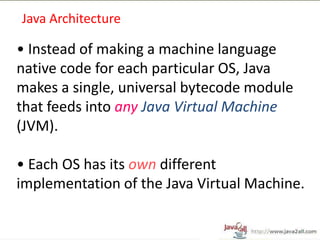




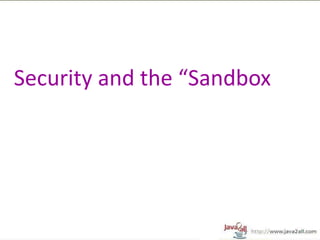







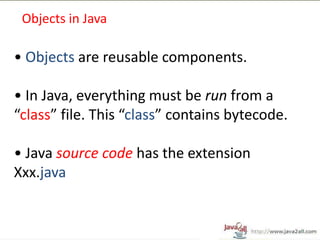



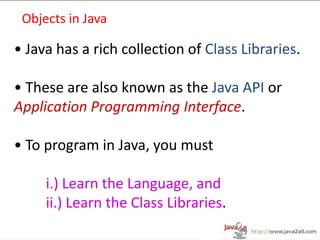





![A Java Application
// HelloWorld.java Our first Java Application
public class HelloWorld
{
public static void main( String args[])
{
System.out.println( “Hello World!” );
}
}
Now our Application is complete. We have added the method “main”.
All methods are lower case. main is a special method--it actually runs
the program.
In any application, you are always guaranteed that method
main will run.](https://image.slidesharecdn.com/java2all1operator-120221031949-phpapp02/85/basic-core-java-up-to-operator-38-320.jpg)
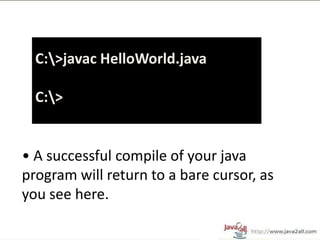




![public class Welcome1
{
public static void main( String args[] )
{
System.out.println( “Welcome to Java!” );
} // end of main()
} // end of class Welcome1
• This is a basic Application.
• Notice the comments. These are required in this course.
Java is free form, but you’ll be happy if you get in the habit
of documenting like this.
• Also, whenever you type an opening curly bracket, type
the closing one right away.
• Your curly brackets must always--in this class--line up as
shown.](https://image.slidesharecdn.com/java2all1operator-120221031949-phpapp02/85/basic-core-java-up-to-operator-44-320.jpg)
![public class Welcome1
{
public static void main( String args[] )
{
System.out.println( “Welcome to Java!” );
} // end of main()
} // end of class Welcome1
• The line above in blue is the class definition for Welcome1.
• Every class name must be Capitalized.
• Notice, every scrap of code is within this class.
• Since it is named Welcome1, this Application is saved in a file
called Welcome1.java, spelled exactly the same.
• The compiler will make a file called Welcome1.class.](https://image.slidesharecdn.com/java2all1operator-120221031949-phpapp02/85/basic-core-java-up-to-operator-45-320.jpg)
![public class Welcome1
{
public static void main( String args[] )
{
System.out.println( “Welcome to Java!” );
} // end of main()
} // end of class Welcome1
• The word Welcome1 is an identifier.
• An identifier is a user-defined word, which consists of:
letters
digits
_ (underscore)
$ (a dollar sign)
• An identifier cannot begin with a digit.](https://image.slidesharecdn.com/java2all1operator-120221031949-phpapp02/85/basic-core-java-up-to-operator-46-320.jpg)
![public class Welcome1
{
public static void main( String args[] )
{
System.out.println( “Welcome to Java!” );
} // end of main()
} // end of class Welcome1
• Notice that we put the word public before the word
class.
• This means the class can be called by anything.
• The alternatives to public are discussed in Chapter 8.](https://image.slidesharecdn.com/java2all1operator-120221031949-phpapp02/85/basic-core-java-up-to-operator-47-320.jpg)
![public class Welcome1
{
public static void main( String args[] )
{
System.out.println( “Welcome to Java!” );
} // end of main()
} // end of class Welcome1
• The method main is also declared public.
• This should just be copied until Chapter 6, when we
know methods better.](https://image.slidesharecdn.com/java2all1operator-120221031949-phpapp02/85/basic-core-java-up-to-operator-48-320.jpg)
![public class Welcome1
{
public static void main( String args[] )
{
System.out.println( “Welcome to Java!” );
} // end of main()
} // end of class Welcome1
• void means nothing is returned to the operating
system when the program finishes.
• The ( String args[] ) works with “arguments”
that were passed when the program was executed.
• Although you cannot omit it ( String args[] ),
we don’t discuss this topic just yet, so please copy it.](https://image.slidesharecdn.com/java2all1operator-120221031949-phpapp02/85/basic-core-java-up-to-operator-49-320.jpg)
![public class Welcome1
{
public static void main( String args[] )
{
System.out.println( “Welcome to Java!” );
} // end of main()
} // end of class Welcome1
• The System.out.println puts the message in
quotes on the command console.
• If we used System.out.print, then the cursor
would not do a carriage return / line the after it prints the
This is called feed
text. Standard output
object.
• Notice the opening and closing blue curly brackets. The
unit of code enclosed in them is called a “block.”
• It is also called the “body” of the method.](https://image.slidesharecdn.com/java2all1operator-120221031949-phpapp02/85/basic-core-java-up-to-operator-50-320.jpg)
![public class Welcome1
{
public static void main( String args[] )
{
System.out.println( “Welcome to Java!” );
} // end of main()
} // end of class Welcome1
• You will find that you very rarely use this
Standard output object.
• Instead, you will use the GUI objects.
• Notice in red the semicolon. ; All executable
statements in Java ends in a semicolon.](https://image.slidesharecdn.com/java2all1operator-120221031949-phpapp02/85/basic-core-java-up-to-operator-51-320.jpg)
![public class Welcome1
{
public static void main( String args[] )
{
System.out.print( “Welcome ” );
System.out.println( “to Java!” );
} // end of main()
} // end of class Welcome1
• This will still produce the same text as the
previous version.](https://image.slidesharecdn.com/java2all1operator-120221031949-phpapp02/85/basic-core-java-up-to-operator-52-320.jpg)
![public class Welcome1
{
public static void main( String args[] )
{
System.out.print( “WelcomentonJava! ” );
} // end of main()
} // end of class Welcome1
• Notice the “ n ”. The slash is an escape
character. It tells the System object that whatever
follows the slash is special:
n new line
t tab
r carriage return Welcome to
Java!
backslash
” quote](https://image.slidesharecdn.com/java2all1operator-120221031949-phpapp02/85/basic-core-java-up-to-operator-53-320.jpg)



![Primitive Data Types
size
• When we assign a type [ int, String] to a
variable, we are not only declaring a memory
location.
• We also decide how big of a number or
character is able to be stored in that variable.](https://image.slidesharecdn.com/java2all1operator-120221031949-phpapp02/85/basic-core-java-up-to-operator-57-320.jpg)








![Primitive Data Types
char
• A char is defined as 2 bytes, no matter which operating
system is used. A char type always
refers to a character in the Unicode encoding
scheme. [uFFFF u is the escape character syntax] About
65,536 different characters can be
represented.
• Single quotes denote a char constant
„H‟ is a char constant
“H” is a string that happens to only contain
a single character.](https://image.slidesharecdn.com/java2all1operator-120221031949-phpapp02/85/basic-core-java-up-to-operator-66-320.jpg)
![Primitive Data Types
char
• A char is defined as 2 bytes. A char type is a single
Unicode character. [uFFFF u is the
escape character syntax--65,536 different characters can be
represented.]
• Single quotes denote a single-letter char constant
„H‟ is a char constant.
“H” is a String that happens to only contain a
single character--it is not a char. This
is a syntax error! The compiler will complain.](https://image.slidesharecdn.com/java2all1operator-120221031949-phpapp02/85/basic-core-java-up-to-operator-67-320.jpg)
![Primitive Data Types
boolean
• A boolean type has only two values.
• In contrast to C/C++, in Java 0 and 1 cannot
stand in for true or false.
• A boolean type must be assigned the value of
the constants true or false.
[Meaning, these exact lowercase words.]](https://image.slidesharecdn.com/java2all1operator-120221031949-phpapp02/85/basic-core-java-up-to-operator-68-320.jpg)
![Java Math Operators
• Addition +
• Subtraction -
• Multiplication *
• Division /
• Modulus %
All are binary operators, i.e., they work with two
numbers. They are executed according to the rules
for operator precedence. [page 1240]
(There is no operator for exponentiation in Java)](https://image.slidesharecdn.com/java2all1operator-120221031949-phpapp02/85/basic-core-java-up-to-operator-69-320.jpg)






![Comparison Operators
• The equality operator is a common source of mistakes:
equality ==
Note that two equal signs are always used.
The single equal sign [ = ] is only used for
assignment, that is, assigning the value on the right to the
variable on the left.
num1 = 33;](https://image.slidesharecdn.com/java2all1operator-120221031949-phpapp02/85/basic-core-java-up-to-operator-76-320.jpg)
